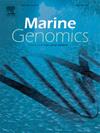Complete genome sequence of Pseudoalteromonas lipolytica M7NS11, a chitinolytic bacterium isolated from the New Britain Trench
IF 1.5
4区 生物学
Q4 GENETICS & HEREDITY
引用次数: 0
Abstract
Pseudoalteromonas, recognized as one of chitin decomposers in marine environments, plays a pivotal role in global carbon and nitrogen cycling. This study reports the whole genome sequence of bacterium M7NS11, which was isolated from deep-sea sediments of the New Britain Trench. Genomic analysis revealed two circular elements: a 3,607,764-bp chromosomal structure (41.79 % GC) and an 899,258-bp plasmid structure (40.87 % GC). Whole-genome analysis revealed that this strain possesses 9 genes encoding chitinases and 1 gene encoding lytic polysaccharide monooxygenase (LPMO), indicating that the strain may efficiently degrade chitin through synergistic interactions between chitinases and LPMO to acquire essential nutrients. Additionally, it contains four genes (amgK, glmU, murA, and murB), encoding enzymes which could utilize chitin degradation products to synthesize peptidoglycan, a major component of cell wall. The analysis of the complete genome of P. lipolytica M7NS11 provides new insights into the role of Pseudoalteromonas in deep-sea material cycling, and underscores the potential of P. lipolytica M7NS11 as a valuable resource for isolating efficient chitinases.
从新不列颠海沟分离的溶几丁质假异单胞菌M7NS11的全基因组序列
假互单胞菌是海洋环境中公认的几丁质分解者之一,在全球碳氮循环中起着至关重要的作用。本文报道了从新不列颠海沟深海沉积物中分离到的细菌M7NS11的全基因组序列。基因组分析显示了两个圆形元素:3,607,764 bp的染色体结构(41.79% GC)和899,258 bp的质粒结构(40.87% GC)。全基因组分析表明,该菌株具有9个编码几丁质酶的基因和1个编码裂解多糖单加氧酶(LPMO)的基因,表明该菌株可能通过几丁质酶与LPMO的协同作用有效降解几丁质,获取必需的营养物质。此外,它还含有amgK、glmU、murA和murB四个基因,这些基因编码的酶可以利用几丁质降解产物合成肽聚糖,这是细胞壁的主要成分。P. lipolytica M7NS11全基因组的分析为伪交单胞菌在深海物质循环中的作用提供了新的见解,并强调了P. lipolytica M7NS11作为分离高效几丁质酶的宝贵资源的潜力。
本文章由计算机程序翻译,如有差异,请以英文原文为准。
求助全文
约1分钟内获得全文
求助全文
来源期刊

Marine genomics
生物-遗传学
CiteScore
3.60
自引率
5.30%
发文量
50
审稿时长
29 days
期刊介绍:
The journal publishes papers on all functional and evolutionary aspects of genes, chromatin, chromosomes and (meta)genomes of marine (and freshwater) organisms. It deals with new genome-enabled insights into the broader framework of environmental science. Topics within the scope of this journal include:
• Population genomics and ecology
• Evolutionary and developmental genomics
• Comparative genomics
• Metagenomics
• Environmental genomics
• Systems biology
More specific topics include: geographic and phylogenomic characterization of aquatic organisms, metabolic capacities and pathways of organisms and communities, biogeochemical cycles, genomics and integrative approaches applied to microbial ecology including (meta)transcriptomics and (meta)proteomics, tracking of infectious diseases, environmental stress, global climate change and ecosystem modelling.
 求助内容:
求助内容: 应助结果提醒方式:
应助结果提醒方式:


